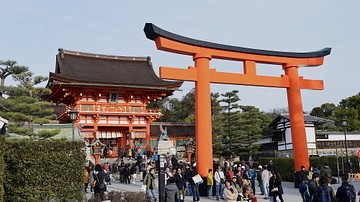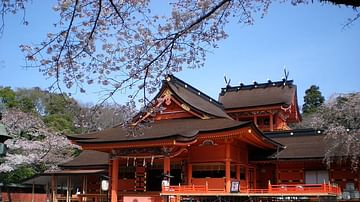
Sumo (Ozumo) is an ancient form of wrestling which has long been the national sport of Japan. Its origins go back to the Yayoi period (c. 300 BCE - c. 300 CE) and it incorporates many elements of the Shinto religion in its various rituals and conventions, the combination of which usually last much longer than the actual sporting contest. Still considered a sacred event, the pavilion in which sumo bouts are performed is regarded as a Shinto shrine.
Origins & Development
The origins of sumo are lost in the mists of time but it is thought to have been first practised sometime in the Yayoi period as part of Shinto rituals where kami or spirits were summoned or 'fought.' Traditionally, the very first sumo wrestler was Nomi no Sukune who was ordered by Emperor Suinin (r. 29 BCE - 70 CE) to fight one Taima no Kehaya. Nomi no Sukune won, perhaps unsurprisingly since he was a descendant of Amenohohi, son of the sun goddess Amaterasu.
In the 8th-century CE Nara period and more certain history, strongman wrestling contests became an important ritual. Sumo fights often involved samurai and these bouts were known as tsuji-zumo in which there were not many rules, deaths were frequent and the prize was cash. The second type of bout was kanjin-zumo which were held at shrines to raise money for their upkeep.
The modern form of the sport took shape at the Shinto shrine of Tomioka Hachimangu in Tokyo. Here, from 1684 CE during the Edo period (1600-1868 CE), regular bouts were organised, notably by the former samurai Ikazuchi Gondayu who created the rules and arena still adhered to today. Sumo wrestlers, often known colloquially as rikishi, then became professional sportsmen who toured the country and sumo became the national sport of Japan. Both sumo wrestlers and sumo wrestling continue to be regarded as sacred in Japan today.
Sumo Shinto Rituals
The explosive physical face-off of a sumo bout is preceded by a lengthy series of rituals and posturing which have origins in ancient warfare and the Shinto religion. One such ritual is the wrestler raising one leg and stamping fiercely down on the ground several times. This derives from the archaic practice of warriors doing this before battle to frighten the enemy and, known as shiki, it was also performed by the goddess Amaterasu when she faced her unruly brother Susanoo in Shinto mythology. Wrestlers also frequently slap their hands together in the pre-fight ritual, another tradition in Shinto when a believer claps to signify the beginning and end of a prayer. Another ritual is for the wrestlers to periodically throw salt across and out from the ring. This is an act of purification, salt long being used for that purpose at Shinto shrines. Finally, the referee (gyoji) of a sumo match is a striking sight in his own right as he wears a robe based on those worn in the imperial court of Japan in medieval times and similar to that of a Shinto priest today.
A Sumo Bout
Two Sumo wrestlers face each other standing within a ring marked out with rope on a raised square platform made of compact clay. The platform measures precisely 5.7 metres (18.7 ft) on each side, and the ring or dohyo is a perfect circle with a diameter of 4.57 metres (15 ft). High above the platform is a roof pavilion, and the whole ensemble continues to enjoy the status of a sacred Shinto shrine which it resembles closely.
The winner of the bout must either push his opponent out of the rope ring or force him down to the ground. If any part of a wrestler's body besides his feet touches the clay flooring then he has lost. The wrestlers, with their hair tied in a complicated topknot in imitation of medieval samurai, wear a mawashi or large belt which can be grabbed by their opponent to push, wrestle, or lift them across and out of the ring. The task of pushing out an opponent may take only a few seconds in the fastest bouts, but the difficulty lies in the tremendous size of the wrestlers. Many sumo wrestlers generally weigh in at 150 kilos (330 pounds) but some of the giants of the sport can weigh over 200 kilos (450 pounds).
Some sumo wrestlers are superstars in Japan, especially those who win tournaments and acquire the prestigious title of yokozuna or grand champion. Nor is the sport limited to Japanese wrestlers as several yokozuna have come from Mongolia and Hawaii. Even the less famous sumo wrestlers are in demand as they are often invited to private homes at the end of winter to rid the house of bad spirits or oni in a ceremony known as setsubun ('second day, second month'). The sumo wrestler throws beans and repeatedly shouts out the phrase Oni wa soto, fuku wa uchi or 'Demons out, good luck in'.
This content was made possible with generous support from the Great Britain Sasakawa Foundation.









